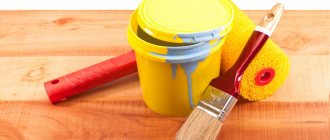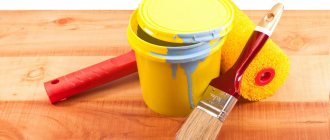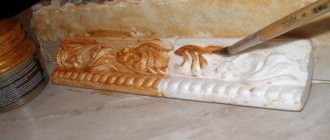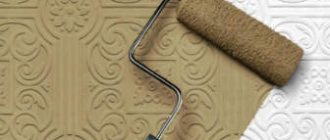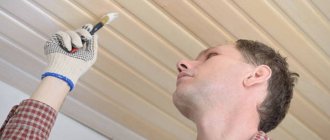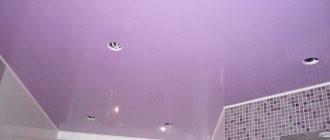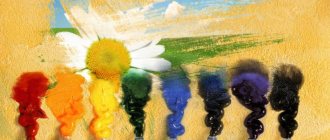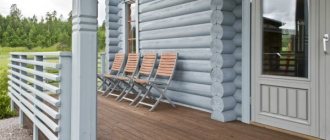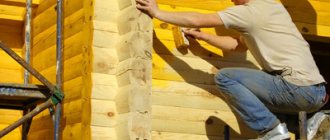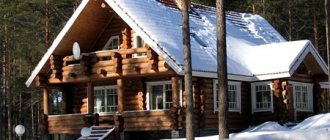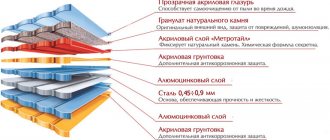Painting chipboard and fiberboard is a responsible procedure that requires compliance with certain rules. For work, certain compositions are used to achieve optimal results. Due to its structure, the material absorbs the applied solution well, so careful preparation is required. The place where the slabs are used is also important, as this involves different levels of exposure.
What paint can be used to paint fiberboard?
The paint for painting fiberboard can be any: water-based ; alkyd; oil; acrylic. If you want to paint a fiberboard floor, you can use ST (super-hard) paint, which is wear-resistant.
READ Is it possible to make an arch in a load-bearing wall?
Water-based paint. Application and features
LMB selection
As already mentioned, before painting the fiberboard on the wall, it should be primed. Considering the characteristics of hardboard, it can be assumed that not every composition is suitable for preparing the surface. The best solution in this case would be deep penetration aqueous primers.
Hardboard is a material that is more porous than solid wood. Deep penetration soil, in turn, will fill the pores and thus minimize the degree of porosity not only on the surface, but throughout the entire thickness of the slab.
The photo shows impregnations that can be used to process fiberboard
Acrylic primers with latex fillers and antiseptic additives have proven themselves to be quite good when applied to porous materials. Such primers not only minimize the porosity of the base, forming a smooth hydrophobic coating, but also prevent the subsequent appearance of mold.
There are no special requirements for the selection of paints and varnishes for application to properly primed hardboard. The fact is that correctly laid soil reduces the moisture permeability of fiberboard, and therefore the paint practically does not penetrate into the thickness of the slab.
The photo shows a range of colors for acrylic coatings
Important: In order to ensure maximum quality of painting, it is advisable to use paint made from the same components as the primer. For example, if acrylic primer is used as a means for preparing hardboard, it is recommended to use acrylic paints, since in this way maximum strength and durability of the coating is achieved.
If the question of how to paint fiberboard is still relevant, we can recommend alkyd enamels, the price of which is considered the most reasonable. To apply such paints and varnishes, the fiberboard surface can be prepared using drying oil as a primer.
Drying oil is applied to the hardboard surface in two layers with the interval necessary for each previous layer to completely dry. High-quality drying oil, as well as acrylic compounds, penetrates into the pores of the slab, forming a moisture-proof surface.
Note! Alkyd enamels can be applied in one or two layers.
Preparing for work
In order to paint fiberboard with high quality with your own hands, you need to carefully prepare for work and assemble equipment before painting. For this you will need:
- roller with fur cover;
- small brush for processing small parts and hard-to-reach areas;
- paint tray;
- spatula for grouting joints between fiber boards;
- vacuum cleaner for cleaning hardboard from dust after sanding and other contaminants.
Features of painting work
Painting the prepared base is easy!
Instructions for painting work on fiberboards begin with applying a primer.
- We attach fine-grained sandpaper to a plaster float with clamps and pass it over the entire surface of the slab. This measure will significantly increase the degree of adhesion of paintwork materials and fiberboard.
- Then carefully sweep the surface with a soft, long-bristled brush to remove all dust.
- Uncork the container with the primer and mix it thoroughly.
- We pour the primer into a paint tray and apply the coating to the surface to be treated using a foam rubber or velor roller. We try not to leave smudges as they will deteriorate the quality of the finished paintwork.
- Apply the primer in two layers with a break of 2 hours for drying. The average impregnation consumption is about 1 liter per 10 square meters.
Important: If there are unsealed gaps where the slabs join, it’s time to putty them. To do this you will need a sickle mesh and wood putty. You can do without a special mesh by simply filling the seam with putty, but there is a possibility that a crack will appear along the mowing line of the seam.
You can proceed to the next stage, that is, painting after the treated base has completely dried. Drying times depend on the temperature and humidity content of the air in the room. On average, we proceed to the next stage in 1-2 days.
For painting we use a velor roller and a maklavitsa brush. A brush is the optimal means for applying paint at junctions and corners.
- Mix the paint and bring it to the required consistency using the thinner specified in the instructions.
- Pour the composition into a painting tray and, immersing the roller in it, apply paint to the base.
- We paint in one or two layers, depending on the characteristics of the paintwork material used and in accordance with the manufacturer’s instructions.
Types of coating
On the shelves of construction stores today there is a very wide variety of all kinds of paints, the packaging of which contains detailed characteristics of the product and for what purpose it is used. Most often, consumers are offered quick-drying paint and, in many cases, odorless, which allows them to carry out work and be in the room calmly, without the risk of poisoning or even a regular headache. When processing fiberboard, you can use the following enamel:
- water-based;
- alkyd;
- oil;
- acrylic.
When choosing a coating, you should consider what surface it is intended for.
For the floor you should choose paint marked CT; it is more resistant to all influences. Alkyd and oil paints are a good option, but finishing with varnish will be required. As for the color palette, it is simply unlimited. You can buy ready-made paint colors or create your own shades using different colors.
Main characteristics of the base
Fiberboards used in construction
The abbreviation DVP stands for the following:
- the letter "P" means slab;
- the letter “D” indicates that the material is made of wood;
- The letter “B” means that the board is not made using solid wood, but from individual fibers, which, by mixing with special resins, are glued together into a material homogeneous in composition.
As a rule, one side of the fiberboard is made laminated. For this reason, this material can be used without painting. But if the color design of the laminated side does not fit into the interior, you will still have to paint the slab.
Before deciding what to paint the fiberboard on the floor or ceiling, the base must be properly prepared. Fiberboard, or hardboard as it is also called, is a porous material prone to excessive absorption of paints and varnishes. Therefore, you initially need to think about how and with what to treat the fiberboard before painting in order to avoid overuse of paint and varnish.
The way out in this situation is to use special primers, which will simultaneously strengthen the surface of the slab and reduce its porosity by an order of magnitude. Once you have decided how to coat the fiberboard before painting, the surface of the base must be sanded to ensure better adhesion to the primer.
READ Is it possible to insulate a house with polystyrene foam from the outside?
Again, when choosing how to paint fiberboard on the ceiling or walls, you need to decide on the type of tools used. Based on our experience, we suggest using a velor roller both when applying primer and when painting, since using a brush and spray is unlikely to achieve the desired result.
Types of compositions suitable for painting fiberboard
- Oil and alkyd enamel. These are wear-resistant coloring materials containing natural or synthetic drying oil. More often, a coating is used that was made on the basis of pentaphthalic drying oil or alkyd resins (PF-226 enamel).
- Acrylic paint with increased wear resistance based on water dispersions. This material is more expensive. It is used for treating floors in living rooms.
- Compositions based on epoxides and alkyd-urethanes. They are a set of two components that are prepared for work, taking into account the service life of the mixtures.
When selecting a suitable composition, it is worth remembering that fiberboard is a cheap material compared to other floor coverings. Therefore, it would be illogical to use expensive mixtures for painting it. Paint and varnish materials must be inexpensive and durable.
An excellent option would be oil-based enamel paint with a hard, wear-resistant base marked “ST”. You can also use decorative or bitumen varnish. When using such materials, they create the illusion of a wood pattern or make the surface glossy.
Water-based paints should not be used to paint fiber sheets. It will not adhere to the surface of the slab, since it is impregnated with paraffin, which protects the pressed sheets from moisture.
When painting a fiberboard ceiling, preference is given to water-soluble materials with the effect of ordinary whitewash.
To achieve the best look, you should carefully hide all seams in the sheets.
Before applying the composition, the surface is degreased with alcohol or products containing this component.
In order to paint a door made of pressed sheets, it is worth considering the following nuances:
- the door is removed from its hinges and placed outside, placed on chairs;
- then painted with the selected composition;
- The fittings are protected from paint splashes with foil or film.
Painting of fiberboard and chipboard
Since doors are subject to less mechanical stress and are an interior detail, preference is given to expensive painting materials that dry quickly and have a rich range of colors.
Surface preparation
It is imperative to take into account an important nuance - before performing any work with fiberboards, the fiberboard is first brought to a certain humidity. Otherwise, over time, the slab will move in waves, thereby ruining the floor or wall. Moistening fiberboard is simple: moisten the back side of the sheet with warm water, and then fold the sheets in pairs. The slabs should be left to dry for a day.
Floors are often made from fiberboard. In order for a fiberboard floor to boast the same service life as a wooden base, it is important to properly treat it, including painting. A hardboard floor is very porous - any paint will be absorbed there in a significant amount than into a concrete or wooden floor.
Experts first suggest covering the surface with a primer - if this is not done, then a positive result can be achieved, but the paint consumption will be very large.
Paint for fiberboard should be applied only to the glossy side of the sheet - the other side is not suitable for this. On the other side, a primer is more appropriate. Due to the peculiarities of its manufacturing and structure, the slab is capable of absorbing 4 times more paint, and applying a primer is one of the stages before painting.
Primer materials are now widely represented on the construction market. Fiberboard and hardboard are traditionally treated with drying oil - this is an affordable and practical product. But the drying oil should be heated to 40 degrees.
Before applying the primer, the slabs are thoroughly cleaned of dust. This can be done either with an ordinary rag or with a vacuum cleaner. The cracks in the floor are sealed with tape or reinforced tape. The entire remaining surface must be degreased - you can use a solvent or alcohol.
The primer is applied with a roller. Experts recommend applying several layers. When the slab is impregnated with drying oil in three layers, the resistance of the material to moisture significantly increases. To increase the service life of hardboard, it is necessary to process it after the cutting is done, but before the laying process.
How to prime hardboard with drying oil
The fiberboard structure is porous and absorbs a large amount of paint, so before painting you need to prime the surface:
- Before priming the hardboard and fiberboard, the drying oil is heated to +40 C - 50 C; the PF brand is used for work. It is not recommended to use a product at home that contains petroleum-polymer resin, as well as compositions with rosin suspension. This drying oil is toxic and takes a long time to dry.
- The surface of the slab is cleared of debris. The gaps at the joints of the sheets are sealed with tape or reinforced tape. The entire area is degreased using alcohol or a solvent (white spirit or acetone based). You need to pay attention to the ends of the sheet; these places are often forgotten to be worked on.
- Fiberboard is primed in 2-3 layers to better saturate the material.
- Apply the primer each subsequent time after complete drying.
- The soil for fiberboard is selected taking into account which part of the sheet will be processed. They also take into account what kind of paint the surface will be painted with. Drying oil, acrylic, which is water-based and most unsuitable for working with fiberboard, has proven itself to be the best.
Dyeing technology
The technology for painting fiber board is no different from painting any other materials. The process is carried out in several stages:
- collection of tools;
- surface preparation for painting;
- choice of paint;
- direct painting;
- application of a protective coating.
We will send the material by email
Fiberboard is a popular material used in construction and renovation. Correct and timely processing will keep practical raw materials unchanged. Often, owners do not know how to paint fiberboard on the ceiling for beauty and protection from moisture. In this review we will look at the intricacies of coloring layers.
Primer
Primers based on acrylic or latex work well with porous slabs. After drying, a thin hydrophobic film is formed on the surface, which does not allow liquid to pass into the fiberboard. Solutions with antiseptic additives have proven themselves to be effective. After application, porosity is minimized and fungus does not form in damp areas.
Acrylic
If you are undecided whether it is possible to paint fiberboard with water-based paint, we recommend choosing acrylic types. Emulsions contain polymers and pure liquid. Easy to apply enamels do not stink, which allows them to be used in residential areas. To paint the ceiling, you do not need to disassemble it and take it outside.
READ How to paint clapboards inside a house with paint
On average, acrylic solutions take 2 hours to dry. To make the coating more dense, apply 2-3 layers. The paints are produced in white color, tinting is carried out with special tint pastes. Enamels are less durable and resistant to external influences than alkyd types.
Preparatory work
The preparation consists of the following:
- Sanding the surface for painting. In addition to eliminating pores, grinding will make the initial roughness of the material more uniform, which will not only facilitate the painting process itself, but will also increase the visual perception of the finished result.
- Putty joints. This is done if several joined fiberboard sheets need to be painted. Not just any putty will do, but only one that is highly flexible, in particular acrylic. It will help tightly fix the contact points of adjacent sheets and thereby facilitate their subsequent painting. It is also acceptable to use sealants based on acrylic or silicone.
- Degreasing the surface with any organic solvent. The operation is carried out so that traces of grinding, as well as excessive oiliness of the surface, do not deteriorate the quality of its painting.
- Primer. Will provide a reduction in the consumption of base paint; at the same time, those pores that could not be eliminated as a result of grinding are simultaneously blocked. The primer should be heated to 40-60°C before use. The viscosity of the primer (usually ordinary drying oil is used, although alkyd primers are also suitable) decreases, and its fluidity increases. The primer coating is applied in one layer.
Hard brushes and rollers on a natural (not foam) base are suitable as working tools for painting fiberboard. The other options are unsuitable, since they will not be able to hide the fibrousness of the original surface, and traces from layers of paint will be very noticeable.
Good results are obtained by painting fiberboard with a spray gun or spray gun, however, the costs with this method of painting will increase. Mechanized painting is justified only for large areas of processing.
Staining algorithm
Having decided how to paint the hardboard on the ceiling, you can begin the application process. Due to porosity, the technology with fibreboards differs from working with wood. We will analyze in detail all the stages of coloring.
A strong odor is the main disadvantage of nitro enamel. When applying paint and varnish, it is better to take hardboard out of the room or use a respirator when working. On the street, the stench disappears as the solution dries.
Nitro enamels cannot be applied in rooms whose humidity is above 70%. If the technology is violated, untidy whitish stains appear on the surface of the material. To get rid of the defect, you will have to completely repaint the coating.
Features of the material
Most novice craftsmen think that painting fiberboard with their own hands is, in general, the easiest thing that can happen in construction or repair work. However, in order for the whole process to be successful and the resulting surface to be pleasing to the eye and of high quality, it is necessary to take into account the characteristics of the material.
Fiberboard is a board consisting of pressed waste from the woodworking industry. The pressure and high temperature under which the plates are made make them light and smooth. They are suitable for making furniture and covering interior surfaces in rooms.
The advantages of this material include the following:
- reasonable price, which is influenced by the fact that the slabs are made from wood waste;
- durability, which allows you to use things for a long time in the manufacture of which fiberboard was involved;
- moisture resistance, but this can be achieved using a special coating at the processing stage;
- long service life - it will depend on proper processing and use of the material.
There aren't many disadvantages. One of them is that the use of fiberboard for arranging load-bearing structures is excluded. Some people are not entirely satisfied with the design of the slabs.
In addition, you need to remember that the slabs themselves cannot be used in wet rooms; they must be carefully treated with special compounds.
Is it possible to paint fiberboard with water-based paint?
Fiberboard material is popular in the manufacture of furniture. These slabs are also often used to cover floors and decorate walls. However, not everyone knows how to paint .
How to paint fiberboard
Fiberboard material is popular in the manufacture of furniture. These slabs are also often used to cover floors and decorate walls. However, not everyone knows how to paint it.
What do you need to paint foam tiles?
To achieve a beautiful and durable result, you need to choose the right coloring composition. So what can you use to paint ceiling tiles? There are two possible options - acrylic and water-based paint. Both materials are non-toxic, easy to apply, dry quickly, have excellent performance characteristics and a wide range of colors.
Do not apply compounds containing acetone, toluene or white spirit to ceiling tiles. These substances easily dissolve foam. Also, do not use alkyd enamels and oil paints.
Foam ceilings can be painted with acrylic or water-based compositions
Types of compositions suitable for painting fiberboard
- Oil and alkyd enamel. These are wear-resistant coloring materials containing natural or synthetic drying oil. More often, a coating is used that was made on the basis of pentaphthalic drying oil or alkyd resins (PF-226 enamel).
- Acrylic paint with increased wear resistance based on water dispersions. This material is more expensive. It is used for treating floors in living rooms.
- Compositions based on epoxides and alkyd-urethanes. They are a set of two components that are prepared for work, taking into account the service life of the mixtures.
When selecting a suitable composition, it is worth remembering that fiberboard is a cheap material compared to other floor coverings. Therefore, it would be illogical to use expensive mixtures for painting it.
Paint and varnish materials must be inexpensive and durable.
An excellent option would be oil-based enamel paint with a hard, wear-resistant base marked “ST”. You can also use decorative or bitumen varnish. When using such materials, they create the illusion of a wood pattern or make the surface glossy.
Water-based paints should not be used to paint fiber sheets. It will not adhere to the surface of the slab, since it is impregnated with paraffin, which protects the pressed sheets from moisture.
When painting a fiberboard ceiling, preference is given to water-soluble materials with the effect of ordinary whitewash.
To achieve the best look, you should carefully hide all seams in the sheets.
Before applying the composition, the surface is degreased with alcohol or products containing this component.
In order to paint a door made of pressed sheets, it is worth considering the following nuances:
- the door is removed from its hinges and placed outside, placed on chairs;
- then painted with the selected composition;
- The fittings are protected from paint splashes with foil or film.
Since doors are subject to less mechanical stress and are an interior detail, preference is given to expensive painting materials that dry quickly and have a rich range of colors.
Paint selection
Painting of fiberboard is carried out using any coloring enamels, but it is better to choose super-hard types of paints. They are marked “ST”.
It is these dyes that will give the floor maximum resistance to wear.
Oil and alkyd paints are used as alternatives.
Water-based paints are not suitable in this case - they will not be able to adhere to the fiberboard coating. The slab contains paraffin - it will repel paint.
You can also use decorative varnish instead of paint. There are also some tricks with which you can create unusual color schemes.
So, to imitate natural wood, you can apply liquid bitumen varnish to the surface with a brush.
To create a paint with a “plastic surface” effect, glossy compounds are used.
Required Tools
To paint a fiberboard floor you need to prepare:
- a fur roller (foam rubber is not suitable for these purposes);
- paint brush;
- paint tray;
- rag;
- vacuum cleaner.
Next, the preparatory stage begins.
Main characteristics of the base
Fiberboards used in construction
The abbreviation DVP stands for the following:
- the letter "P" means slab;
- the letter “D” indicates that the material is made of wood;
- The letter “B” means that the board is not made using solid wood, but from individual fibers, which, by mixing with special resins, are glued together into a material homogeneous in composition.
Sources:
https://styles-interiors.ru/kakoy-kraskoy-mozhno-pokrasit-dvp/ https://v-nashem-mire.ru/info/mozhno-li-krasit-dvp-vodojemulsionnoj-kraskoj/ https:// m-strana.ru/articles/chem-pokrasit-dvp-na-potolke/ https://stroiintel.ru/chem-pokrasit-orgalit-na-potolke/
ConstructionDialogue
When choosing an inexpensive but reliable material for finishing walls, partitions or floors, at some point you will come across hardboard. This type of panels is widely used in decoration and construction. In addition, it is used for the production of furniture. Let's consider what hardboard is, why it is interesting and where it is used.
Material and its advantages
Hardboard is a fibreboard made from wood waste, recycled cellulose and similar raw materials. Available in the form of sheet panels of various sizes.
In essence, this is the familiar fiberboard, but manufactured to higher quality standards.
The following circumstances contribute to the popularity of this material:
- Low price;
- Wide scope of application;
- Convenient release form in the form of plates;
- The dimensions of the hardboard sheet can be different, including width;
- Availability of models with decorative processing (lamination), thanks to which panels of various colors are available to us;
- Good machinability;
- Decent performance characteristics (strength, reliability).
Compound
Each panel manufacturer has its own vision of the optimal composition. However, most plates contain:
- Mentioned wood industry waste as a base component;
- An adhesive composition that holds fibers together under high pressure and at least high temperatures (as a rule, these are synthetic resins);
- Hydrophobic additives that provide resistance to moisture (paraffin, rosin);
- Antiseptics that reduce the likelihood of rotting, mold development and damage by microorganisms;
- Fire retardants that worsen the combustion of the material and increase fire safety;
- Strength enhancers in the form of various polymers.
Safety
In connection with the composition just indicated, many have a legitimate question: is hardboard harmful to health?
In general, no, but there are a couple of “buts”. Some panel manufacturers use phenol-formaldehyde, which is dangerous to humans. Russian GOST 4598-86 prohibits the use of such substances. Moreover, this is an outdated production technology, used only by underground factories.
Require a certificate of compliance with GOST, and you will protect yourself.
The second subtle point is combustion. When exposed to heat, some substances in the composition of hardboard can form dangerous compounds. However, if your interior partition is on fire, you will have more serious problems.
Under normal conditions, high-quality slabs are completely harmless.
Kinds
There are a great many types of this material. From the point of view of the basic parameter - density - all slabs can be divided into three categories:
- Soft. It has a relatively low density and a cork-like structure. It is used as an insulator when finishing walls and ceilings, as well as in the construction of interior partitions. If you need hardboard on the floor to level the horizontal, then this option is perfect.
- Solid. Here, the sheet density is approximately 1.5 times higher than that of the previous version, which makes the material stronger. It is characterized by better resistance to moisture and has good bending strength. It is actively used in construction and decoration, as well as in furniture production.
- Super hard. These panels are more than 2 times denser than the first option. They are used in construction, furniture industry and even in automobile production.
In addition, the panels may have different surface treatments. Laminated hardboard, in which one or two sides have a decorative coating, is very popular in the decoration and production of furniture.
If you are choosing hardboard for walls, it is advisable to choose sheets with one decorative surface or without lamination at all (for subsequent painting).
Where is it used?
As we have already said, this is a popular material for solving various problems. Among them:
- Arrangement of thermal insulation in a house or apartment;
- Installation of interior partitions;
- Leveling floors or arranging a base for flooring;
- Furniture manufacturing;
- Production of interior doors and so on.
How can I cut panels?
Hardboard slabs are available in different sizes, which allows you to choose the one most suitable for your purposes. However, when installing partitions, wall panels or laying floors, it is unlikely to be possible without cutting.
The hardboard itself is easy to cut. There are only two problems:
- The edges of the cut may turn out to be torn due to the structure of the material;
- The decorative layer of the laminate can crack and chip.
How to cut hardboard to avoid these negative effects?
The best option is a jigsaw with a fine saw. Manual cutting can be done with a hacksaw (it also has fine teeth), pressing it against a ruler. This way you will get an even cut and will not damage the decorative coating. For large volumes of work, it is advisable to order cutting at a specialized institution where a circular saw will be used.
Lonely Master
Fiberboard or fibreboards are sheets made from wood fibers by pressing and cutting into slabs of a certain size, so this surface absorbs paint well and requires coating with drying oil or some other composition.
Preparing for painting
In order to paint fiberboard on the ceiling, if there is old paint, it should be removed if possible. This is done using a hair dryer,
it has a higher temperature and volume of blown air compared to a household hair dryer.
Under the influence of hot air, the old paint softens and can be easily separated from the fiberboard with a metal spatula.
Next, you need to sand the fiberboard surface with the remnants of the old coating, dry it to reduce paint consumption, but if paint consumption does not matter much to you, then you don’t have to dry it. .
After the surface of the fiberboard is prepared for applying paint and the paint itself is selected, you can begin to work.
Painting of fiberboard
Painting of fiberboard on the ceiling is done with a roller,
Painting fiberboard on the ceiling with a roller
Painting fiberboard on the ceiling with a brush
Painting fiberboard on the ceiling with a spray gun
Painting is done in several layers. The first layer is applied perpendicular to the light falling from a window onto the ceiling or from artificial lighting. The last layer of paint is applied parallel to the rays of light. The number of layers of paint applied can be up to three; each layer should not be thick, so you can get a more durable coating.
If the color is applied across the light rays, then shadows in the form of threads are formed on the strokes (stripes) and the unevenness of the ceiling becomes noticeable.
If the room has windows on two or three sides, then the finishing touches of paint are directed along the length of the ceiling.
If you apply the first layers of paint manually with a brush and the last with a roller with a medium-length pile, you will get a perfectly even coating.
When painting with a spray gun, you must first apply a primer layer of diluted paint, and then, after the paint has dried, a subsequent layer of undiluted paint of the same color.
The paint must dry naturally; heat or drafts are not allowed while the paint is drying.
If there were defects in the painting, unpainted paint, primer showing through, etc., then painting is done again.
